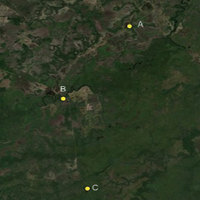Ecological characterization of mosquitoes (Diptera: Culicidae) in areas of the Mato Grosso Pantanal, Mato Grosso State, Brazil

Accepted: 1 June 2021
HTML: 14
All claims expressed in this article are solely those of the authors and do not necessarily represent those of their affiliated organizations, or those of the publisher, the editors and the reviewers. Any product that may be evaluated in this article or claim that may be made by its manufacturer is not guaranteed or endorsed by the publisher.
Bimonthly diurnal and nocturnal captures were conducted in four different sampling sites of the Mato Grosso Pantanal region over 24 consecutive months between March 2009 and January 2011. The goal of performing these collections was to elucidate aspects of the biology and ecology of mosquitoes in this region since little to nothing is known about these aspects for many species. A total of 17,532 specimens were captured, comprising two subfamilies, nine genera, and 44 species. The main species of culicids found in the Mato Grosso Pantanal had strong ecological compatibility with well-preserved environments and with some of the specific habitats found in at least one of the four selected collection sampling sites. Anopheles darlingi, An. albitarsis, and An. triannulatus are well-suited to environments with large water bodies and greater anthropic activity. Culex nigripalpus and Cx. quinquefasciatus prefer environments with bush fragments and pronounced human action and movement. Culex declarator and Psorophora albigenu, the most eclectic, prefer wild areas and with some anthropic activity. Mansonia titillans is associated with environments offering a wide variety of natural breeding areas that enable its development, in particular natural swamp areas covered with macrophytes, which is one of the natural components of the Pantanal biome. The effect of the flooding season on the population density of anophelines is especially advantageous, with an explosion in the number of individuals in periods of widespread flooding. The region’s environmental dynamics are regulated by flooding cycles with alternating periods of flooding and drought, which are the main factors governing the ecology of the local fauna and flora. Flooding periods contribute to raising culicid species’ richness and diversity, while the droughts result in a more even distribution of specimens within species. The flooding season of the Pantanal occurs between November and May and coincides with the greatest abundance of culicid species. During this period, the human population of the region has greater contact with mosquito vectors carrying pathogens, including arboviruses, which previous studies have confirmed via seropositivity in the region’s equines and birds.
Supporting Agencies
Furnas Centrais ElétricasPAGEPress has chosen to apply the Creative Commons Attribution NonCommercial 4.0 International License (CC BY-NC 4.0) to all manuscripts to be published.


 https://doi.org/10.4081/tz.2021.84
https://doi.org/10.4081/tz.2021.84



